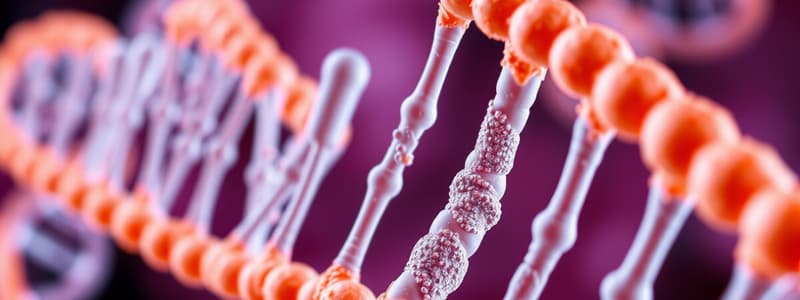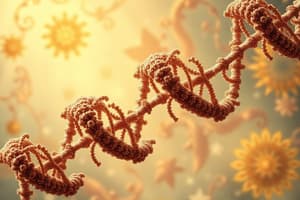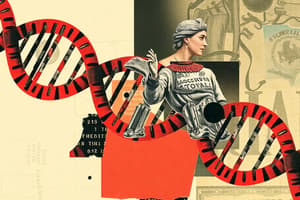Podcast
Questions and Answers
Which of the following builds new strands of DNA?
Which of the following builds new strands of DNA?
- DNA polymerase (correct)
- RNA polymerase
- Helicase
- DNA ligase
Which statement best describes strand characteristics as it relates to DNA replication?
Which statement best describes strand characteristics as it relates to DNA replication?
The leading strand is built continuously, and the lagging strand is built in pieces.
During DNA replication, which nucleotide will bind to an A nucleotide in the original or parental DNA strand?
During DNA replication, which nucleotide will bind to an A nucleotide in the original or parental DNA strand?
T
Which protein joins together the Okazaki fragments of the DNA lagging strand?
Which protein joins together the Okazaki fragments of the DNA lagging strand?
DNA ligase adds nucleotides to the lagging strand.
DNA ligase adds nucleotides to the lagging strand.
During which phase of the cell cycle does DNA duplication occur?
During which phase of the cell cycle does DNA duplication occur?
When a double helix of DNA is replicated, what are the two complete helices called?
When a double helix of DNA is replicated, what are the two complete helices called?
During which phase of mitosis do sister chromatids line up at the center of the cell?
During which phase of mitosis do sister chromatids line up at the center of the cell?
During which phase of mitosis do sister chromatids move apart?
During which phase of mitosis do sister chromatids move apart?
During which phase of mitosis do nuclear envelopes and nucleoli reappear?
During which phase of mitosis do nuclear envelopes and nucleoli reappear?
During which phase of mitosis do the nuclear envelope and nucleoli disappear?
During which phase of mitosis do the nuclear envelope and nucleoli disappear?
What is the name of the process by which the cytoplasm divides in two?
What is the name of the process by which the cytoplasm divides in two?
Which of the following lists, in correct order, the phases of interphase?
Which of the following lists, in correct order, the phases of interphase?
Which of the following lists, in correct order, the phases of mitosis?
Which of the following lists, in correct order, the phases of mitosis?
During which phase does DNA replication occur?
During which phase does DNA replication occur?
During which phase does chromatin condense and become chromosomes?
During which phase does chromatin condense and become chromosomes?
Which of the following events occurs during transcription?
Which of the following events occurs during transcription?
Which of the following is a correct statement about mRNA?
Which of the following is a correct statement about mRNA?
What is the site of translation?
What is the site of translation?
DNA plays a role in translation.
DNA plays a role in translation.
MRNA attaches to the small subunit of a ribosome during RNA processing.
MRNA attaches to the small subunit of a ribosome during RNA processing.
Match the stage of interphase with the event that occurs.
Match the stage of interphase with the event that occurs.
DNA is replicated during which subphase of interphase?
DNA is replicated during which subphase of interphase?
Match the stage of interphase with the event that occurs: The cell is metabolically active, synthesizing proteins, and growing rapidly.
Match the stage of interphase with the event that occurs: The cell is metabolically active, synthesizing proteins, and growing rapidly.
Which nucleic acid is involved in transcription but not translation?
Which nucleic acid is involved in transcription but not translation?
Which of the following concerning the nuclear envelope is particularly important in mitosis?
Which of the following concerning the nuclear envelope is particularly important in mitosis?
The mRNA start codon AUG matches up with a tRNA anticodon.
The mRNA start codon AUG matches up with a tRNA anticodon.
Match the form of tRNA with its function.
Match the form of tRNA with its function.
Match the stage of mitosis with the event(s) that occur(s): prophase.
Match the stage of mitosis with the event(s) that occur(s): prophase.
Match the form of RNA with its function: mRNA.
Match the form of RNA with its function: mRNA.
Match the stage of the cell cycle with the events that occur: cytokinesis.
Match the stage of the cell cycle with the events that occur: cytokinesis.
Match the form of RNA with its function: rRNA.
Match the form of RNA with its function: rRNA.
Flashcards
What is DNA polymerase?
What is DNA polymerase?
An enzyme responsible for building new DNA strands by adding nucleotides one at a time.
What is the leading strand?
What is the leading strand?
The continuous strand of DNA synthesized during replication, running in the 5' to 3' direction.
What is the lagging strand?
What is the lagging strand?
The discontinuously synthesized strand of DNA, formed in short segments called Okazaki fragments.
What is DNA ligase?
What is DNA ligase?
Signup and view all the flashcards
How does adenine pair with thymine?
How does adenine pair with thymine?
Signup and view all the flashcards
What is the S phase?
What is the S phase?
Signup and view all the flashcards
What are sister chromatids?
What are sister chromatids?
Signup and view all the flashcards
What happens during metaphase?
What happens during metaphase?
Signup and view all the flashcards
What happens during anaphase?
What happens during anaphase?
Signup and view all the flashcards
What happens during telophase?
What happens during telophase?
Signup and view all the flashcards
What happens during prophase?
What happens during prophase?
Signup and view all the flashcards
What is cytokinesis?
What is cytokinesis?
Signup and view all the flashcards
What is transcription?
What is transcription?
Signup and view all the flashcards
What is messenger RNA (mRNA)?
What is messenger RNA (mRNA)?
Signup and view all the flashcards
What is translation?
What is translation?
Signup and view all the flashcards
How does protein synthesis begin?
How does protein synthesis begin?
Signup and view all the flashcards
What is transfer RNA (tRNA)?
What is transfer RNA (tRNA)?
Signup and view all the flashcards
What are the stages of interphase?
What are the stages of interphase?
Signup and view all the flashcards
What is RNA processing?
What is RNA processing?
Signup and view all the flashcards
What is the role of tRNA's anticodon?
What is the role of tRNA's anticodon?
Signup and view all the flashcards
What is the function of mRNA?
What is the function of mRNA?
Signup and view all the flashcards
What is the function of ribosomal RNA (rRNA)?
What is the function of ribosomal RNA (rRNA)?
Signup and view all the flashcards
Why is the nuclear envelope important for mitosis?
Why is the nuclear envelope important for mitosis?
Signup and view all the flashcards
What is the sequence of phases in mitosis?
What is the sequence of phases in mitosis?
Signup and view all the flashcards
Why is DNA replication important for mitosis?
Why is DNA replication important for mitosis?
Signup and view all the flashcards
What is the cell cycle?
What is the cell cycle?
Signup and view all the flashcards
What is the result of mitosis?
What is the result of mitosis?
Signup and view all the flashcards
What is the centromere?
What is the centromere?
Signup and view all the flashcards
What are spindle fibers?
What are spindle fibers?
Signup and view all the flashcards
Why is mitosis important?
Why is mitosis important?
Signup and view all the flashcards
Study Notes
DNA Replication
- DNA polymerase is an enzyme responsible for synthesizing new strands of DNA by adding nucleotides one at a time.
- The leading strand is synthesized continuously, while the lagging strand is formed in segments known as Okazaki fragments.
- DNA ligase is the enzyme that joins Okazaki fragments on the lagging strand.
- Adenine (A) pairs with thymine (T) during DNA replication.
Cell Cycle and Mitosis
- DNA replication occurs during the S phase of interphase.
- Sister chromatids are the two identical halves of a duplicated chromosome formed during replication.
- Key phases of mitosis include:
- Metaphase: Sister chromatids align at the cell's center.
- Anaphase: Sister chromatids are pulled apart to opposite poles.
- Telophase: Nuclear envelopes and nucleoli reappear as the cell prepares to divide.
- Prophase: Chromatin condenses into visible chromosomes, and the nuclear envelope disintegrates.
Cytokinesis
- Cytokinesis is the process of dividing the cytoplasm into two daughter cells following mitosis.
RNA and Protein Synthesis
- Transcription involves the synthesis of RNA from a DNA template.
- Messenger RNA (mRNA) transports genetic information from the nucleus to the cytoplasm after RNA processing.
- The translation process occurs at ribosomes in the cytoplasm, utilizing mRNA and transfer RNA (tRNA).
- mRNA codon AUG pairs with tRNA anticodon UAC to initiate protein synthesis.
- tRNA decodes mRNA and delivers the corresponding amino acids to ribosomes for polypeptide formation.
Interphase and its Phases
- Interphase consists of three stages: G1 (cell growth), S (DNA synthesis), and G2 (preparation for mitosis).
- During the S phase, DNA replication occurs, ensuring each daughter cell receives an identical set of chromosomes.
RNA Processing
- RNA processing involves modifications to mRNA before it leaves the nucleus, but does not include the attachment of mRNA to ribosomes.
Forms of RNA
- tRNA uses an anticodon to match and deliver amino acids to the ribosome.
- mRNA carries genetic instructions for protein synthesis.
- Ribosomal RNA (rRNA) is a structural component of ribosomes, aiding in protein synthesis.
Mitosis Importance
- The nuclear envelope plays a critical role during mitosis, regulating the transport of genetic material.
Phases of Mitosis in Sequence
- Correct order of mitosis phases: Prophase, Metaphase, Anaphase, Telophase.
Studying That Suits You
Use AI to generate personalized quizzes and flashcards to suit your learning preferences.



